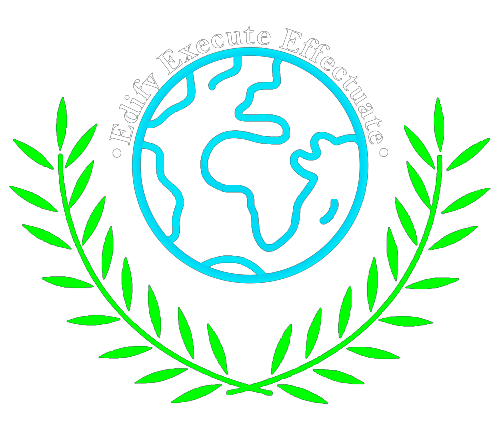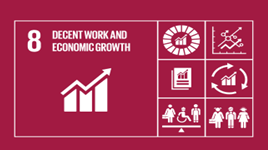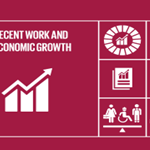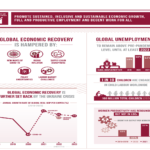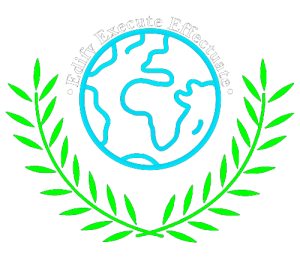By Middat Khan
The Sustainable Development Goals (SDGs), established by the United Nations in 2015, provide a global vision for achieving prosperity, equity and sustainability by 2030 Its goal is to promote inclusive and sustainable economic growth, employment and decent work for all, and to recognize the importance of economic development in reducing poverty and maintaining social stability. . In India, where the economy is diverse and dynamic, achieving SDG 8 is both a challenge and an opportunity.
Understanding SDG 8: Key Objectives and Targets
SDG 8 has several key goals and objectives, including promoting sustainable economic growth, ensuring employment products and ensure fair employment for all. The specific goals and targets under SDG 8 are:
- Target 1: Sustainable Economic Growth
- Sustain per capita economic growth under national circumstances and aim for at least 7% GDP growth per annum in the least developed countries.
- Target 2: Diversify, Innovate, and Upgrade for Economic Productivity
- Achieve higher levels of economic productivity through diversification, technological upgrading, and innovation, particularly in high value added and labour-intensive sectors.
- Target 3: Promote Policies to Support Job Creation and Growing Enterprises
- Promote development-oriented policies that support productive activities, decent job creation, entrepreneurship, creativity, and innovation. Encourage the formalization and growth of micro, small, and medium sized enterprises, including through access to financial services.
- Target 4: Improve Resource Efficiency in Consumption and Production
- Improve global resource efficiency in consumption and production, aiming to decouple economic growth from environmental degradation by 2030.
- Target 5: Full Employment and Decent Work with Equal Pay
- By 2030, achieve full and productive employment and decent work for all, including equal pay for equal value work for both men and women.
- Target 6: Promote Youth Employment, Education, and Training
- By 2020, substantially reduce the proportion of youth not in employment, education, or training.
- Target 7: End Modern Slavery, Trafficking, and Child Labour
- Take immediate measures to eradicate forced labour, and modern slavery and human trafficking, and secure the prohibition and elimination of the worst forms of child labour.
- Target 8: Protect Labour Rights and Promote Safe Working Environments
- Protect labour rights and promote safe working environments, particularly for migrant workers and those in precarious employment.
- Target 9: Promote Beneficial and Sustainable Tourism
- By 2030, implement policies to promote sustainable tourism that create jobs and promote local culture and products.
- Target 10: Universal Access to Banking, Insurance, and Financial Services
- Strengthen domestic financial institutions to expand access to banking, insurance, and financial services for all.
- Target 11: Increase Aid for Trade Support
- Increase Aid for Trade support for developing countries, particularly least developed countries, to enhance trade-related technical help.
- Target 12: Develop a Global Youth Employment Strategy
- Develop and operationalize a global strategy for youth employment and implement the Global Jobs Pact of the International Labour Organization.
India’s Progress and Challenges in Achieving SDG 8
India’s progress and challenges in achieving SDG 8 India, with its large population and complex economic landscape, faces unique challenges in achieving SDG 8. High levels of performance lawlessness, regional differences in economic growth and the need for skills development are some of the cases. Key Issues However, India has made significant progress through various policies and programs aimed at promoting decent work and sustainable economic growth. Policies and priorities in India support of SDG 8, it is increasing employment in various sectors. The aim of the program is to create a skilled workforce by providing short-term training, emphasis on prior learning (RPL) and specific programs to develop sectors.
Key Policies and Programs in India Supporting SDG 8
1.Pradhan Mantri Kaushal Vikas Yojana (PMKVY)
Launched: 2015
Status: Continuing
Objective: From providing skill development training to the youth of India, raising their employability in various sectors. The program aims to create a skilled workforce by offering short-term training, recognition of prior learning (RPL), and special projects in developing sectors.
Impact: As of 2023, PMKVY has trained over 13 million youth across the country in various skills. The scheme has seen an important push toward skill development in emerging sectors as digital technology, healthcare, and engineering. The placement rate for trained candidates stands at around 54%, showing the program’s effectiveness in enhancing employability.
- Start-Up India Initiative
Launched: 2016
Status: Continuing
Objective: To promote entrepreneurship and innovation by providing financial support, tax benefits, and to provide simpler rules for startups. The initiative aims to create jobs, promote economic growth, and encourage entrepreneurship across the country.
Impact: The Start-Up India project has acknowledged over 100,000 startups since its inception. India has become the third-largest startup ecosystem in the world. In 2022 alone, Indian startups raised around $42 billion in funding. The initiative has also led to the creation of approximately 6.5 lakh jobs directly within the startup ecosystem, according to the Department for Promotion of Industry and Internal Trade (DPIIT).
- Make in India
Reinvigorated: 2014,
Status: Continuing with renewed focus
Objective: To transform India into a global manufacturing hub by encouraging domestic and international companies to manufacture their products in India. The initiative focuses on creating jobs, enhancing skills, and supporting economic growth in sectors like electronics, textiles, and automobiles.
Impact: The manufacturing sector’s contribution to GDP has increased from 15.06% in 2014 to 17.4% in 2023. The initiative has attracted FDI inflows worth $286 billion from 2014 to 2022. Main sectors like electronics, textiles, and automobiles have seen significant growth, with India becoming the second-largest mobile phone manufacturer globally by 2022.
- Atmanirbhar Bharat (Self-Reliant India)
Launched: 2020
Status: Continue
Objective: In response to the economic challenges presented by the COVID-19 pandemic, this initiative aims to make India self-reliant by boosting local production, reducing dependence on imports, and creating jobs. It includes various financial incentives for small and medium enterprises, workers and farmers to promote economic growth and employment.
Impact: The Atmanirbhar Bharat initiative has been involved in increasing domestic production, particularly in sectors like healthcare, manufacturing, and MSMEs. Under this initiative, over 10 million MSMEs have benefited from the Emergency Credit Line Guarantee Scheme (ECLGS), leading to the restoration of small businesses and job creation. India’s GDP growth rebounded to 7.2% in 2021-22 after the pandemic-induced slowdown, partially driven by the Atmanirbhar Bharat packages.
- MUDRA Yojana (Micro Units Development and Refinance Agency)
Launched: 2015
Status: Continuing
Objective: To provide financial support to micro and small enterprises, especially those initiated by individuals and small groups in the sector Unstructured MUDRA funds are aimed at strengthening small businesses, creating jobs and encouraging entrepreneurship, and contribute to economic growth at the appropriate level.
Impact: MUDRA Yojana has reached over 35 million beneficiaries since its inception in March 2020. It has disbursed 15.52 crore loans million about 68% of the borrowers are women and 51% belong to SC/ST/OBC category which shows the inclusion of the scheme. This program has played an important role in promoting small businesses and entrepreneurship, and has contributed to job creation at a significant level.
Case Studies: Success Stories from India
- Tamil Nadu’s Skill Development Initiatives
- Impact and Progress:
- Skill Training: Tamil Nadu Skill Development Corporation (TNSDC) has trained more than 1.5 million people in various sectors such as in IT and Automotive and Textiles, since its inception. The government is a leader in skill development by focusing on industry-related training that meets the needs of the local economy
- Employment: Tamil Nadu’s unemployment rate is lower than the national average. According to the Center for Monitoring the Indian Economy (CMIE) by 2022, the state’s unemployment rate will be around 3.2 percent, compared to the national average of 7.6 percent
- Economic Contribution: Emphasis on skill development has helped the state’s economic growth, with Tamil Nadu achieving a gross domestic product (GSDP) growth rate of around 8% by 2022- 23. The state’s diverse economy, supported by a skilled workforce, is key to driving this growth.
- Gujarat’s MSME Growth
- Impact and Progress:
- MSME Ecosystem: The MSME sector in Gujarat has grown significantly, with over 3.4 million MSMEs registered by 2022. Infrastructure development and ease of doing business updates.
- Job Creation: The MSME sector in Gujarat is a significant contributor to employment, providing jobs to around 7.5 million people. The state’s focus on promoting entrepreneurship and facilitating access to finance has played a crucial role in reducing unemployment and supporting inclusive growth.
- Economic Growth: Gujarat’s GDP has grown at an average rate of 10% in the last ten years and the MSME sector has played a major role in this growth. Government policies helped diversify the economy and make it more resilient to economic shocks.
- Kerala’s Kudumbashree Mission
- Impact and Progress:
- Women Empowerment: Kudumbashree has empowered more than 4.5 million women across Kerala and organized them into 300,000 Self Help Groups (SHG). Opportunities for self-employment, entrepreneurship and income generation have been provided for these women, which has improved their socio-economic conditions.
- Economic Contribution: Kudambashari projects have given rise to more than 100,000 micro-enterprises, which contribute significantly to the local economy. This mission also plays an important role in reducing poverty and improving living standards in rural areas.
- Social Impact: Beyond economic benefits, Kudumbashree has been instrumental in social development, including improving health, education, and gender equality. The model has been so successful that it is being replicated in other states and countries.
The Role of Businesses and Individuals in India’s Journey Towards SDG 8
The role of entrepreneurship and individuals in India’s journey towards SDG 8Apart from government policies, the private sector is playing an important role in India to promote SDG 8. Business is paying attention to business. . Corporate Social Responsibility (CSR) programs promote education, skill development and employment.
Tata Consultancy Services (TCS)
- Impact and Progress:
- Digital Literacy and Skill Development: TCS’s “Bridge-IT” program has reached over 100,000 individuals in rural and semi-urban areas, providing them with digital literacy and vocational training. This has improved employability and access to jobs in these areas.
- Job Creation: TCS is one of the largest private-sector employers in India, with a workforce of over 600,000 as of 2023. The company’s focus on skill development and digital inclusion has contributed to broader economic growth and social progress.
- CSR Initiatives: TCS spends a significant portion of its profits on CSR activities, focusing on education, health, and rural development. These initiatives have had a positive impact on communities across India, particularly in underdeveloped regions.
- Hindustan Unilever’s Project Shakti
- Impact and Progress:
- Empowerment of Women: Project Shakti has trained and empowered over 140,000 rural women to become micro-entrepreneurs. These women, known as “Shakti Ammas,” distribute Unilever products in their communities, providing them with a steady income and economic independence
- Economic Growth: The initiative has not only created a new distribution channel for Unilever but has also contributed to economic growth in rural areas by promoting entrepreneurship and improving access to consumer goods.
- Social Impact: Project Shakti has improved the standard of living for thousands of families and has been recognized as a successful model for rural economic development and women’s empowerment.
Individuals can also contribute by participating in skill development programs, supporting ethical businesses, and advocating for fair labour practices. Volunteering with organizations that focus on creating jobs, supporting local businesses and promoting financial literacy are ways people can help achieve SDG 8. and economic development Although challenges remain, especially when it comes to expanding these models and making them sustainable, according to the data. real and measurable impacts across sectors. These programs are well documented by government reports, corporate social responsibility reports and independent assessments from organizations such as the World Bank, NITI Aayog and UNDP
Conclusion
India’s journey towards achieving SDG 8 reflects a combination of government initiatives, private sector partnerships and community action that promotes fair jobs, economic growth and social justice. Programs such as PMKVY, Start-Up India and Kudumbashree have succeeded in skill development, job creation and entrepreneurship, encouraging inclusive growth in various sectors. While challenges remain, especially in addressing informality and regional disparities, the measurable impacts of these initiatives demonstrate India’s commitment to sustainable development and the achievement of the SDG goals.
